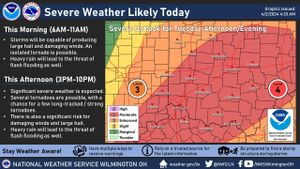A Denver-based company is set to revive the era of supersonic air travel, potentially offering transatlantic flights at prices comparable to current commercial flights but with significantly shorter travel times. This ambitious new venture is being referred to as the “son of Concorde,” which pays homage to the iconic supersonic jet renowned for its luxurious service and unmatched speed.
The Concorde famously transported passengers across the Atlantic from London to New York in just under three hours, flying at 1,350 mph at altitudes of 60,000 feet. Its celebrated tagline, “Arrive Before You Leave,” encapsulated its capability of reaching the destination before technically departing. But with Concorde's retirement in 2003, the excitement of supersonic travel faded—until now.
Boom Supersonic, the driving force behind the new generation of supersonic passenger jets, is developing aircraft capable of cruising at speeds of Mach 1.7—twice as fast as the fastest commercial aircraft currently operational. The company has already garnered significant interest, securing orders from major airlines like American Airlines, United Airlines, and Japan Airlines, which signals strong demand for this technology.
A major milestone was recently achieved when Boom's demonstrator aircraft, known as XB-1, successfully broke the sound barrier during high-speed runs over California’s Mojave Desert. Former British Airways Concorde pilot, Mike Bannister, expressed his awe after witnessing the XB-1 accelerate past Mach 1.1 (850 mph). “It’s absolutely amazing to see a supersonic aircraft flying again. The industry has gone backwards since Concorde stopped, but we’re now on a strong pathway to bringing a supersonic airliner back to service,” he remarked.
Blake Scholl, founder of Boom Supersonic, is optimistic about the return of this type of air travel, noting the growing demand for speedier flights. He argues, “We should make flying faster. We should make it more sustainable,” reflecting his commitment to addressing current climate concerns. Scholl points out significant market research indicating 97% of passengers would prefer supersonic flights if they are safe, affordable, and environmentally conscious.
The main hurdle faced by Concorde was its exorbitant ticket prices. Adjusted for today’s inflation, travelers could spend up to £20,000 for a ticket—a cost many were unwilling to bear. This high price combined with the tragic crash of 2000 and the devastating impacts of the 9/11 attacks on air travel led to dwindling demand for Concorde. Scholl highlights the competitive pricing of their new aircraft: “Think £5,000 for a round trip, which is what people pay to travel in business anyway.”
Expected to enter service by 2029, the Overture will accommodate approximately 65 passengers and be priced around £200 million. When operational, it promises to reduce flight times significantly—London to New York will take just three and a half hours as opposed to the current seven, and journeys from Paris to New York will be cut to about four hours. Likewise, flights between London and Miami will drop from nine and a half hours to under five, benefitting busy business executives and travelers alike.
For operational compliance, Boom’s Overture will only reach supersonic speeds over oceans, creating the opportunity to operate on nearly 600 routes globally. Yet, challenges remain, highlighted by the past collapse of rival Aerion Supersonic, which shut down operations after losing key financial backers like Boeing and General Electric. Scholl acknowledges these challenges, stating, “What we’ve set out to do here is not for the faint of heart. A lot of people said we would definitely fail, and we still could fail. But I think what we demonstrated last week is we could also succeed.”
With passengers hungry for faster travel options and airlines eager to offer cutting-edge services, the potential for supersonic commercial air travel to make its long-awaited comeback appears promising. Observers can only wait and see whether Boom Supersonic will overcome the formidable challenges and bring this dream of supersonic flight to fruition.



